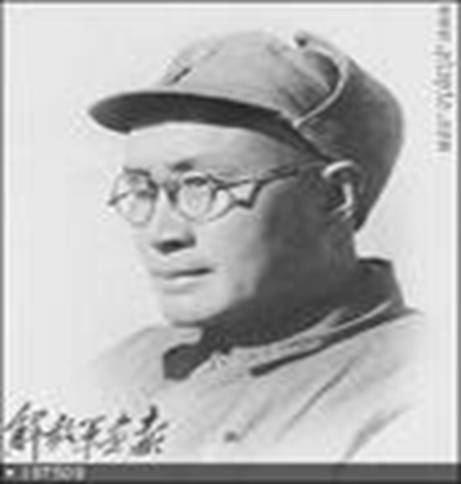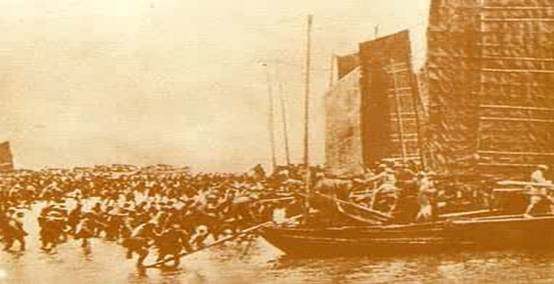(Relations between the Nationalist and Communist Parties 1945-1949)
Part VI, What Has Led China to Where She Is Now
Presenter: Wang Ronghua
Summary
The Second Civil War (termed by the Communist as “The War of Liberation” or “The Third Domestic Revolutionary War”, and by the Nationalist as “War of Anti-Communism, Safeguarding State and Suppressing the Rebellion”) is a war to liberate China from the rule of Kuomintang by the People’s Liberation Army under the leadership of the CPC and with the support of the broad masses of the people. It was a long term war between the troops of the CPC and the troops of the Kuomintang in the middle of the 20th century in China. It is also the largest civil war in the modern history of the world. It ended with the founding of the People’s Republic of China on October 1, 1949.
Background
The first atom bomb was dropped on Hiroshima on Aug 6, 1945. The Soviet Union declared war on Japan on Aug. 8 and its troops then marched into Northeast China. The Japanese Emperor announced the unconditional surrender on Aug. 15. On September 2, Japan formally surrendered to the Allied Forces. The Central Committee ordered in the later half of Aug to entered into the Northeast, almost 100,000 troops arrived at Rehe (a former province with its capital in Chengde), Chahaer (a former province with its capital in Zhangjiakou) and the Northeast by various means of travel.
Later in the year, Chiang Kai-shek realized that he lacked the resources to prevent a CPC takeover of Manchuria following the scheduled Soviet departure. He therefore made a deal with the Russians to delay their withdrawal until he had moved enough of his best-trained men and modern material into the region. KMT troops were then airlifted by the United States to occupy key cities in North China, while the countryside was already dominated by the CPC. The Soviets spent the extra time systematically dismantling the extensive Manchurian industrial base (worth up to 2 billion dollars) and shipping it back to their war-ravaged country.
the terms of the Japanese unconditional surrender dictated by the United States, Japanese troops were ordered to surrender to KMT troops and not to the CPC present in some of the occupied areas. In Manchuria the Japanese surrendered to the Soviet Union. However the KMT had no forces in Manchuria. Chiang Kai-Shek, while ordering the Japanese troops to remain at their post to receive the Kuomintang and not surrender their arms to the communists, he sent troops to Japanese occupied areas day and night, and at the same time, telegraphed Mao Zedong inviting him to Chongqing for talks.
Mao Zedong Arrived in Chongqing for Negotiations


Chongqing Negotiations

Background
The Kuomintang authorities were not prepared at all for talks with Mao, an evidence of lack of sincerity. The procedures, proposals were put forward by the Communist delegation. Mao met Chiang several times to talk about founding of the state by peaceful means. Specifics were dealt with by Zhou Enlai, Wang Ruofei on the Communist side and by Wang Shijie, Zhang Qun, Zhang Zhizhong and Shao Lizi on the Nationalist side. After heated discussions, the two sides signed a minute of the meeting between “the government and the representatives of the Communist Party” on October 10, 1945 (also know as “Double Ten Agreement”), which dealt with 12 issues including basic policies for founding the state, democratic politics, national congress, cooperation among parties, nationalization of armies, local governments in liberated areas. In particular, the Nationalist side accepted the basic policies for founding the state proposed by the Communists and agreed that civil war should be avoided.
The Outbreak of Civil War
Yet, after the Nationalist troops entered into the Northeast and other places originally occupied by the Japanese, the Nationalist government refused to recognize the legitimacy of political powers established by the Communist troops that got to the Japanese occupied areas earlier. Thus, large scale armed clashes broke out. The US then sent the Secretary of State Marshall to China to mediate, even though a preliminary agreement was reached, the short-lived cooperation came to a stop when the Nationalists convened one-sidedly the National Congress when the Communists strongly opposed such an act. In June 1946, Kuomintang troops waged a sudden attack on Communist troops in the Central Plain area, the civil war thus broke out nation-wide. The United States, even though at the start assisted the KMT with hundreds of millions of dollars worth of new surplus military supplies and generous loans of hundreds of millions of dollars worth of military equipment. They airlifted many KMT troops from central China to the Northeast, stopped all assistance at this juncture.

Li Xiannian led the Central Field Troops breaking the encirclement by 200,000 Kuomintang troops.
Su Yu, who won seven important battles in the central part of Jiangsu, especially the battle that wiped out the ace troop—the 74th division of Kuomintang.

Su Yu and his comrades on the left photo; Zhang Lingpu (on the right photo) commander of the 74th Division who was killed at the battle.


Kuomintang’s Northwest Major Offensive Was Frustrated

200,000 Kuomintang troops occupied an empty Yen’an. The PLA’s guerrilla and mobile warfare seriously weakened Kuomintang forces.
The troops led by Liu Bocheng (left photo) and Deng Xiaoping (right photo) went into Dabie Mountains after traveling over 1,000 miles and posed a threat to such important cities as Wuhan.


Kuomintang Occupied Areas
1、There were serious economic and political crises;
2、Patriotic and democratic movement was surging high.
Liaoning and Shenyang Campaign
The People’s Liberation Army started counteroffensive from September 1948 when they waged the Liaoning and Shenyang Campaign, which is one of the three major campaigns that overthrown the Kuomintang rule on the mainland.
By the time of September 1948, there were only 500,000 Kuomintang troops in the Northeast as against the 1 million of the PLA. More than 97% of land area and 86% of people had been liberated by the PLA. PLA;s Northeast Field Army headed by Lin Biao and Luo Ronghuan started the campaign on Sept. 12 with 53 divisions, more than 700,000 troops.
The PLA troops took Jinzhou first to separate Kuomintang troops from other parts of the country.
They then wiped out the Liao Yaoxiang Legion in the west part of Liaoning.
And finally they took Shenyang.
The campaign lasted for 52 days and wiped out over 470,000 Kuomintang troops. The entire Northeast was liberated.

Beiping-Tianjin Campaign
Beiping-Tianjin Campaign from Nov. 29, 1948 to Jan. 31, 1949 was waged by the Northeast Field Army, the 2nd and 3rd Corps of Northern China Region and some local armed forces in Beiping (today’s Beijing), Tianjin and ZhangJiakou. This was a decisive battle with the Kuomintang troops and one of the three campaigns in the War of Liberation.
The PLA first of all divided up the Kuomintang troops, blocked ways of their escape to the south and west.
The PLA wiped out troops in Tianjin and Zhangjiakou, leaving Beiping as an isolated city.
The commander of the troops in Beiping agreed to reorganize the troops into PLA, thus the city was liberated without war.
The campaign lasted for 64 days, the PLA casualties were 39,000; the Kuomintang troops that were killed, wounded or captured were over 520,000.

The Northeast Field Army entered into the Shanhaiguan Pass for the Beiping-Tianjin Campaign
Peaceful Liberation of Beiping
Kuomintang soldiers welcoming PLA

Huaihai Campaign
Huaihai Campaign started on Nov. 6, 1948 and ended on Jan. 10, 1949. The casualties of the PLA were the heaviest, yet the Nationalist troops it killed were the highest, it was very complicated in ways of battle, and its political influence was the greatest.
On Nov. 10, the Huang Baitao Corps of the Kuomintang was divided up and enclosed by the PLA in the east of Xuzhou, after 10 days of battle, over 100,000 troops were killed, wounded or captured, the Commander Huang Baitao committed suicide.
Liu Bocheng and Deng Xiaoping in the Commanding Position of the Huaihai Campaign

On Nov. 23, the PLA encircled 12 divisions of the Kuomintang troops who came to assist the Huang Baitao Corps. By Dec. 15, over 120,000 troops were wiped out.
Between Jan. 6-10, 300,000 Kuomintang troops were killed, wounded or captured.
In a matter of 65 days, 550,000 troops of the Kuomintang were wiped out, posing a direct threat to Nanjing.
On April 21, Communist forces crossed the Yangtze River, capturing Nanjing, capital of the KMT's Republic of China. In most cases, the surrounding countryside and small towns had come under Communist influence long before the cities. By late 1949, the People's Liberation Army was pursuing remnants of KMT forces southwards in southern China.
On October 1, 1949, Mao Zedong proclaimed the People's Republic of China with its capital at Peiping, which was renamed Beijing. Chiang Kai-shek and approximately 2 million Nationalist Chinese retreated from mainland China to the island of Taiwan. The two sides have never signed any agreement or treaty to officially end the war yet.
The PLA Crossing the Yangtze River

The PLA Took Over Nanjing

Mao Zedong, Zhou Enlai and Ren Bishi on the Rostrum of Tiananmen

